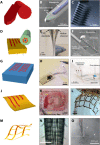Next-generation probes, particles, and proteins for neural interfacing
- PMID: 28630894
- PMCID: PMC5466371
- DOI: 10.1126/sciadv.1601649
Next-generation probes, particles, and proteins for neural interfacing
Abstract
Bidirectional interfacing with the nervous system enables neuroscience research, diagnosis, and therapy. This two-way communication allows us to monitor the state of the brain and its composite networks and cells as well as to influence them to treat disease or repair/restore sensory or motor function. To provide the most stable and effective interface, the tools of the trade must bridge the soft, ion-rich, and evolving nature of neural tissue with the largely rigid, static realm of microelectronics and medical instruments that allow for readout, analysis, and/or control. In this Review, we describe how the understanding of neural signaling and material-tissue interactions has fueled the expansion of the available tool set. New probe architectures and materials, nanoparticles, dyes, and designer genetically encoded proteins push the limits of recording and stimulation lifetime, localization, and specificity, blurring the boundary between living tissue and engineered tools. Understanding these approaches, their modality, and the role of cross-disciplinary development will support new neurotherapies and prostheses and provide neuroscientists and neurologists with unprecedented access to the brain.
Keywords: Neural interface.
Figures








References
-
- Deep-Brain Stimulation for Parkinson’s Disease Study Group, Deep-brain stimulation of the subthalamic nucleus or the pars interna of the globus pallidus in Parkinson’s disease. N. Engl. J. Med. 345, 956–963 (2001). - PubMed
-
- Ondo W., Jankovic J., Schwartz K., Almaguer M., Simpson R. K., Unilateral thalamic deep brain stimulation for refractory essential tremor and Parkinson’s disease tremor. Neurology 51, 1063–1069 (1998). - PubMed
-
- Greenberg B. D., Malone D. A., Friehs G. M., Rezai A. R., Kubu C. S., Malloy P. F., Salloway S. P., Okun M. S., Goodman W. K., Rasmussen S. A., Three-year outcomes in deep brain stimulation for highly resistant obsessive–compulsive disorder. Neuropsychopharmacology 31, 2384–2393 (2006). - PubMed
-
- Mayberg H. S., Lozano A. M., Voon V., McNeely H. E., Seminowicz D., Hamani C., Schwalb J. M., Kennedy S. H., Deep brain stimulation for treatment-resistant depression. Neuron 45, 651–660 (2005). - PubMed
-
- Bouton C. E., Shaikhouni A., Annetta N. V., Bockbrader M. A., Friedenberg D. A., Nielson D. M., Sharma G., Sederberg P. B., Glenn B. C., Mysiw W. J., Morgan A. G., Deogaonkar M., Rezai A. R., Restoring cortical control of functional movement in a human with quadriplegia. Nature 533, 247–250 (2016). - PubMed
Publication types
MeSH terms
Grants and funding
LinkOut - more resources
Full Text Sources
Other Literature Sources

